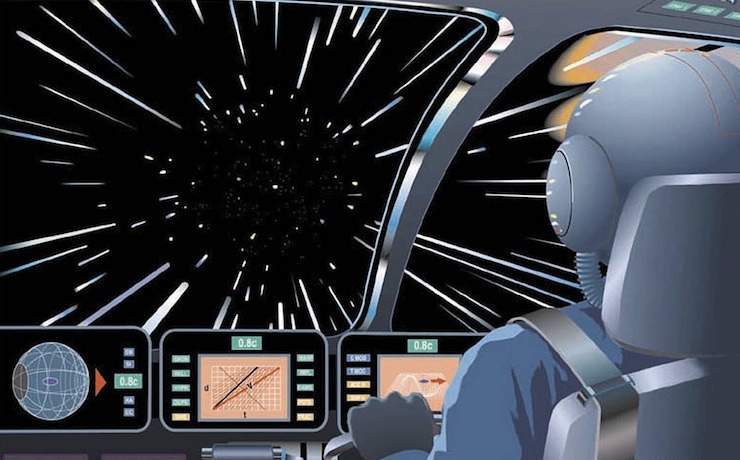
Five Ways Science Fiction Writers Dodge The Problem Of Relativity
relativity! The evidence backs this up pretty well, but it’s pretty inconvenient for science fiction writers who want a short trip to the galactic core to be as easy as popping up on the road. Consider that the universe is so large that light would anatomically need to meander through a single galaxy for as long as modern humans have existed, add a very strict C speed limit, and you’re faced with a cosmic reality that Making it very simple that many authors may want to write is physically impossible. So… what’s a hardworking science fiction writer to do?
ignore this question
By far the most popular options are to ignore the problem or actively deny that it is a problem. Maybe Einstein divided when he should have multiplied (he didn’t). With enough will, it might be possible to travel faster than the speed of light (it can’t). What if some miracle material for which there is absolutely no evidence of existence could facilitate faster-than-light travel? (More likely, no such material exists.)
One might forgive earlier examples, such as Dr. Smith’s “Space Lark,” because the novel was written early enough that relativity hadn’t won the overwhelming consensus it now enjoys through a body of evidence. I don’t know if physicists of the day would have agreed, but they might have conceded that Smith’s wave of the hand made possible a thrilling tale of interstellar travel on a galactic scale unconstrained by physics or fundamental literary values.
More than a century of research has shown Einstein to be right, but that hasn’t stopped authors from imagining faster-than-light drives. Julia E. Czerneda’s 2001 In the Company of Others features convenient and affordable faster-than-light travel, not to mention a plethora of easily terraformable planets suitable for human exploitation. The cost: If exploring the galaxy was easy, you might encounter a life form you’d better never come into contact with. In this case, that would be the quill, a seemingly harmless life form that has wiped out all human life on the colony world by the beginning of the novel.
accept the universe as it is
Yes, that meant giving up the dream of a galactic community where a meek person could send a message to Sirius by breakfast and get a reply by lunch. But…accepting universal speed limits and scale just rules out most interstellar adventures. Fun is still possible in our solar system! Well, backtracking a bit, relativity doesn’t rule out interstellar adventures, as long as one accepts that such endeavors are inherently difficult and time-consuming…
Arthur C. Clarke’s 1975 “Empire Earth” is set on the occasion of the U.S. quincentennial, sending Duncan Makenzie from his home planet of Titan to Earth. The ostensible reason for the trip was diplomatic engagement between the United States and the resource-focused Titans. Side projects include saving Titan’s economy from being destroyed by an impending drop in demand for its main export, and dealing with Duncan’s overwrought love life.
Ari North’s 2020 webcomic/graphic novel Always Human is also set in a not-too-distant future where life-enhancing body modifications are available to most (but not everyone) people. Austin was one of the unlucky few. She suffers from an autoimmune disease and cannot use mods. Fascinated by an imaginary Austin she created based on a few brief public transit encounters, Sunati managed to seduce Austin. Will the relationship last or will it be doomed due to inherent communication issues and career choices?
Yes, there is travel within the solar system in this webcomic/novel.
moving stars
Insisting on scientific plausibility would seem to rule out interstellar travel, at least convenient interstellar travel. There is a loophole. It’s entirely possible to use one or more stars that are closer to our setup than we currently have, since the stars will move.
In John Brenner’s 1982 book “Catch a Shooting Star,” astronomer Creo Han observed a star heading straight for the solar system. The consequences of a close encounter can be disastrous. Inconveniently for Creohan, his Earth is a decadent one—even if it has the means to deal with the crisis, it doesn’t seem to have the will.
More recently (but somehow still decades ago) Donald Moffitt’s 1989 orientalist space opera series Mechanical Sky featured an ambitious sultan with a profound understanding of interstellar distances. The solution is to use Moffett’s sweeping misunderstanding of fundamental physics and some weird aspects of near-light travel to move the stars themselves. Even a cubic light-year is a very large space, large enough to accommodate a large number of systems.
time dilation
Relativity itself provides a useful coping mechanism in the form of time dilation. The duration of the trip varies from observer to observer. When the relative speed is low, the clocks are aligned. Travelers traveling at or near the speed of light would experience shorter times than measured on Earth. The problem is, travelers returning home will find that the world has been changed by time.
The golden age of the Busad ramjet is full of such stories. In Larry Niven’s 1976 “Obsolete World,” reincarnated 20th-century man Jerome Branch Corbell hijacks a Pasteur stamping entrusted to him engine, and made a short round trip to the galactic core. Millions of years later, Kerber meets the black hole at the core of the galaxy and returns to the solar system whose inhabitants have greatly altered our home system during this time.
extend your life
In the end, maybe the problem isn’t that interstellar travel is inherently time-consuming. Perhaps the real problem is that humans are fragile mayflies. Significantly extended life, once a voyage much longer than any reasonable life, is at least achievable, if not practical.
Consider Linda Nagata’s 1998 Vast. Not only do its characters inhabit sublight starships far superior to any we’ve built right now, but they have access to life-extending technology that, under the right circumstances, can make death itself a temporary inconvenience. Considering the hostile galaxy they’re exploring, this life-extending technique is invaluable.
***************************
These are just some of the options for authors who want to acknowledge the speed of light limit while still creating thrilling space adventures. No doubt there are some neat alternatives I’ve overlooked or didn’t have room for. Feel free to mention them in the comments below.







Tagged 1:1 spin-orbit resonance, Earth, exoplanet, Mercury, Science fiction